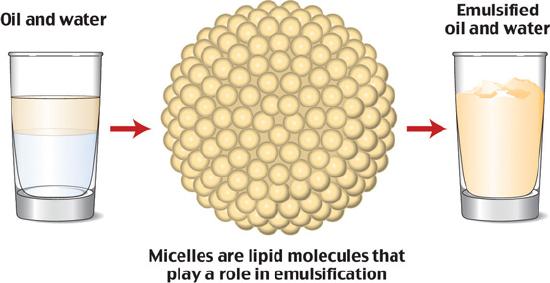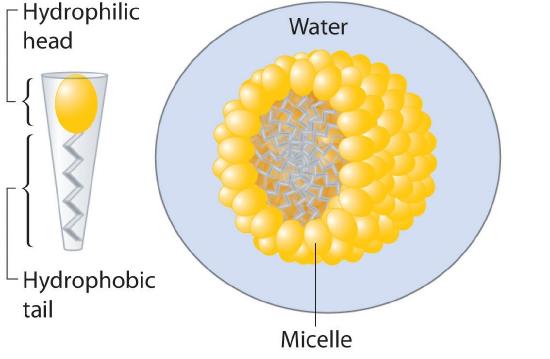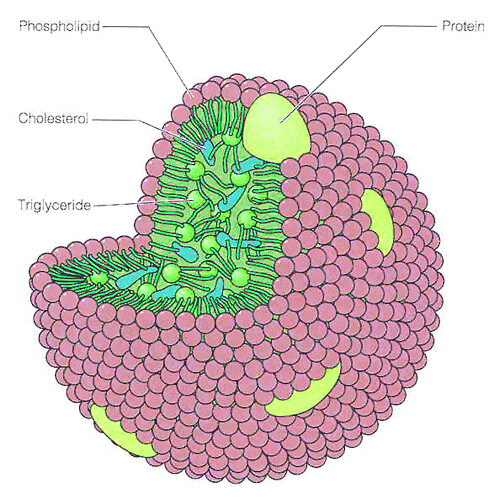5.2: Digestion and Absorption of Lipids
- Page ID
- 21124
Learning Objectives
- Summarize the steps in lipid digestion and absorption.
- Explain how lipids are used for energy and stored in the body.
Lipids are large molecules and generally are not water-soluble. Like carbohydrates and protein, lipids are broken into small components for absorption. Since most of our digestive enzymes are water-based, how does the body break down fat and make it available for the various functions it must perform in the human body?
From the Mouth to the Stomach
Remember that the building blocks of lipids are triacyglycerols and phospholipids, here we will discuss how they are digested and absorbed. The first step in the digestion of triacylglycerols and phospholipids begins in the mouth as lipids encounter saliva. Next, the physical action of chewing coupled with the action of emulsifiers enables the digestive enzymes to do their tasks. The enzyme lingual lipase, along with a small amount of phospholipid as an emulsifier, initiates the process of digestion (Figure \(\PageIndex{1}\)). These actions cause the fats to become more accessible to the digestive enzymes. As a result, the fats become tiny droplets and separate from the watery components.

In the stomach, gastric lipase starts to break down triacylglycerols into diglycerides and fatty acids (Figure \(\PageIndex{1}\)). Within two to four hours after eating a meal, roughly 30 percent of the triacylglycerols are converted to diglycerides and fatty acids. The stomach’s churning and contractions help to disperse the fat molecules, while the diglycerides derived in this process act as further emulsifiers. However, even amid all of this activity, very little fat digestion occurs in the stomach.
Going to the Bloodstream
Fats are not digested and absorbed easily because they are insoluble in water. However, with the help of bile (from the liver) and digestive enzymes (from the pancreas), lipid digestion takes place in the small intestine. In fact, the majority of lipid digestion takes place in the small intestine. Micelles transport the end products of lipid digestion (free fatty acids and monoglycerides) to the digestive tract lining for absorption. As stomach contents enter the small intestine, the digestive system sets out to manage a small hurdle, namely, to combine the separated fats with its own watery fluids. The solution to this hurdle is bile. Bile is produced by the liver and stored in the gallbladder; when needed bile is secreted from the gallbladder into the small intestine. Bile contains bile salts, lecithin, and substances derived from cholesterol so it acts as an emulsifier. It attracts and holds on to fat while it is simultaneously attracted to and held on to by water. Emulsification increases the surface area of lipids making them more accessible to the digestive enzymes (Figure \(\PageIndex{2a}\)).
Once the stomach contents have been emulsified, fat-breaking enzymes (known as lipases) work on the triacylglycerols and diglycerides to sever fatty acids from their glycerol foundations. As pancreatic lipase enters the small intestine, it breaks down the fats into free fatty acids and monoglycerides. Yet again, another hurdle presents itself. How will the fats pass through the watery layer of mucous that coats the absorptive lining of the digestive tract? As before, the answer is bile. Bile salts envelop the fatty acids and monoglycerides to form micelles. Micelles have a fatty acid core with a water-soluble exterior (Figure \(\PageIndex{2b}\)). This allows efficient transportation to the intestinal microvillus. Here, the fat components are released and disseminated into the cells of the digestive tract lining.


Just as lipids require special handling in the digestive tract to move within a water-based environment, they require similar handling to travel in the bloodstream. Inside the intestinal cells, the monoglycerides and fatty acids reassemble themselves into triacylglycerols. Triacylglycerols, cholesterol, and phospholipids form lipoproteins when joined with a protein carrier. Lipoproteins have an inner core that is primarily made up of triacylglycerols and cholesterol esters (a cholesterol ester is a cholesterol linked to a fatty acid). The outer envelope is made of phospholipids interspersed with proteins and cholesterol (Figure \(\PageIndex{3a}\)). A chylomicron (Figure \(\PageIndex{3b}\)) is a large lipoprotein that is used to transport fat from a meal. Once formed, chylomicrons are transported from the intestinal lining to the lymphatic system and will soon be released into the bloodstream via the jugular vein in the neck. Chylomicrons transport food fats perfectly through the body’s water-based environment to specific destinations such as the liver and other body tissues. Short- and medium-chain fatty acids are absorbed more quickly since they are not arranged into chylomicrons.

Figure \(\PageIndex{3a}\): Lipoprotein structure (CC BY-SA 2.0; AJC1 via Flickr)

Figure \(\PageIndex{3b}\): Chylomicron structure (CC BY 3.0; OpenStax)
Cholesterols are poorly absorbed when compared to phospholipids and triacylglycerols. Cholesterol absorption is aided by an increase in dietary fat components and is hindered by high fiber content. This is the reason that a high intake of fiber is recommended to decrease blood cholesterol. Foods high in fiber such as fresh fruits, vegetables, and oats can bind bile salts and cholesterol, preventing their absorption and carrying them out of the colon for excretion.
Storing and Using Body Fat
Adipose (fat) tissue is the body's storage system for extra calories/fuel. One way the body stores fat involves the body's transformation of carbohydrates into glycogen (which is stored in the muscles for energy). When the muscles reach their capacity for glycogen storage, the excess is returned to the liver, where it is converted into triacylglycerols and then stored as fat.
In a similar manner, much of the triacylglycerols the body receives from food is transported to fat storehouses within the body if not used for producing energy. The chylomicrons are responsible for shuttling the triacylglycerols to various locations such as the muscles, breasts, external layers under the skin, and internal fat layers of the abdomen, thighs, and buttocks where they are stored by the body in adipose tissue for future use. Triglycerides can also be used to make lipid-containing compounds needed by the body. How is this accomplished? Recall that chylomicrons are large lipoproteins that contain a triacylglycerol and fatty-acid core. Capillary walls contain an enzyme called lipoprotein-lipase that dismantles the triacylglycerols in the lipoproteins into fatty acids and glycerol, thus enabling these to enter into the adipose cells. Once inside the adipose cells, the fatty acids and glycerol are reassembled into triacylglycerols and stored for later use. Muscle cells may also take up the fatty acids and use them for muscular work and generating energy. When a person’s energy requirements exceed the amount of available fuel presented from a recent meal or extended physical activity has exhausted glycogen energy reserves, fat reserves are retrieved for energy utilization.
As the body calls for additional energy, the adipose tissue responds by dismantling its triacylglycerols and dispensing glycerol and fatty acids directly into the blood. Upon receipt of these substances the energy-hungry cells break them down further into tiny fragments. These fragments go through a series of chemical reactions that yield energy, carbon dioxide, and water.
Key Takeaways
- In the stomach fat is separated from other food substances. In the small intestines bile emulsifies fats while enzymes digest them. The intestinal cells absorb the fats.
- Long-chain fatty acids form a large lipoprotein structure called a chylomicron that transports fats through the lymph system.
- Chylomicrons are formed in the intestinal cells and carry lipids from the digestive tract into circulation.
- Cholesterol absorption is hindered by foods high in fiber.
- When energy supplies are low the body utilizes its stored fat reserves for energy.

